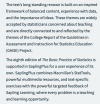- Joined
- Apr 23, 2002
- Professional Status
- Certified General Appraiser
- State
- Oregon
"The (R-squared) , (also called the coefficient of determination), which is the proportion of variance (%) in the dependent variable that can be explained by the independent variable. Hence, as a rule of thumb for interpreting the strength of a relationship based on its R-squared value (use the absolute value of the R-squared value to make all values positive):
- if R-squared value < 0.3 this value is generally considered a None or Very weak effect size,
- if R-squared value 0.3 < r < 0.5 this value is generally considered a weak or low effect size,
- if R-squared value 0.5 < r < 0.7 this value is generally considered a Moderate effect size,
- if R-squared value r > 0.7 this value is generally considered strong effect size,
Ref: Source: Moore, D. S., Notz, W. I, & Flinger, M. A. (2013). The basic practice of statistics (6th ed.). New York, NY: W. H. Freeman and Company. Page (138)."
Since there are so many variables in the buying and selling of residential real estate, I've always thought it was speculative to rely on statistical analysis for adjustments. I only have one very homogenous neighborhood in my market, when I run a correlation on living area differences, I get a R2 of 0.77 and consider it significant, and then I round it up and adjust close to where I think the market is actually seeing it with very simple analysis.
- if R-squared value < 0.3 this value is generally considered a None or Very weak effect size,
- if R-squared value 0.3 < r < 0.5 this value is generally considered a weak or low effect size,
- if R-squared value 0.5 < r < 0.7 this value is generally considered a Moderate effect size,
- if R-squared value r > 0.7 this value is generally considered strong effect size,
Ref: Source: Moore, D. S., Notz, W. I, & Flinger, M. A. (2013). The basic practice of statistics (6th ed.). New York, NY: W. H. Freeman and Company. Page (138)."
Since there are so many variables in the buying and selling of residential real estate, I've always thought it was speculative to rely on statistical analysis for adjustments. I only have one very homogenous neighborhood in my market, when I run a correlation on living area differences, I get a R2 of 0.77 and consider it significant, and then I round it up and adjust close to where I think the market is actually seeing it with very simple analysis.




